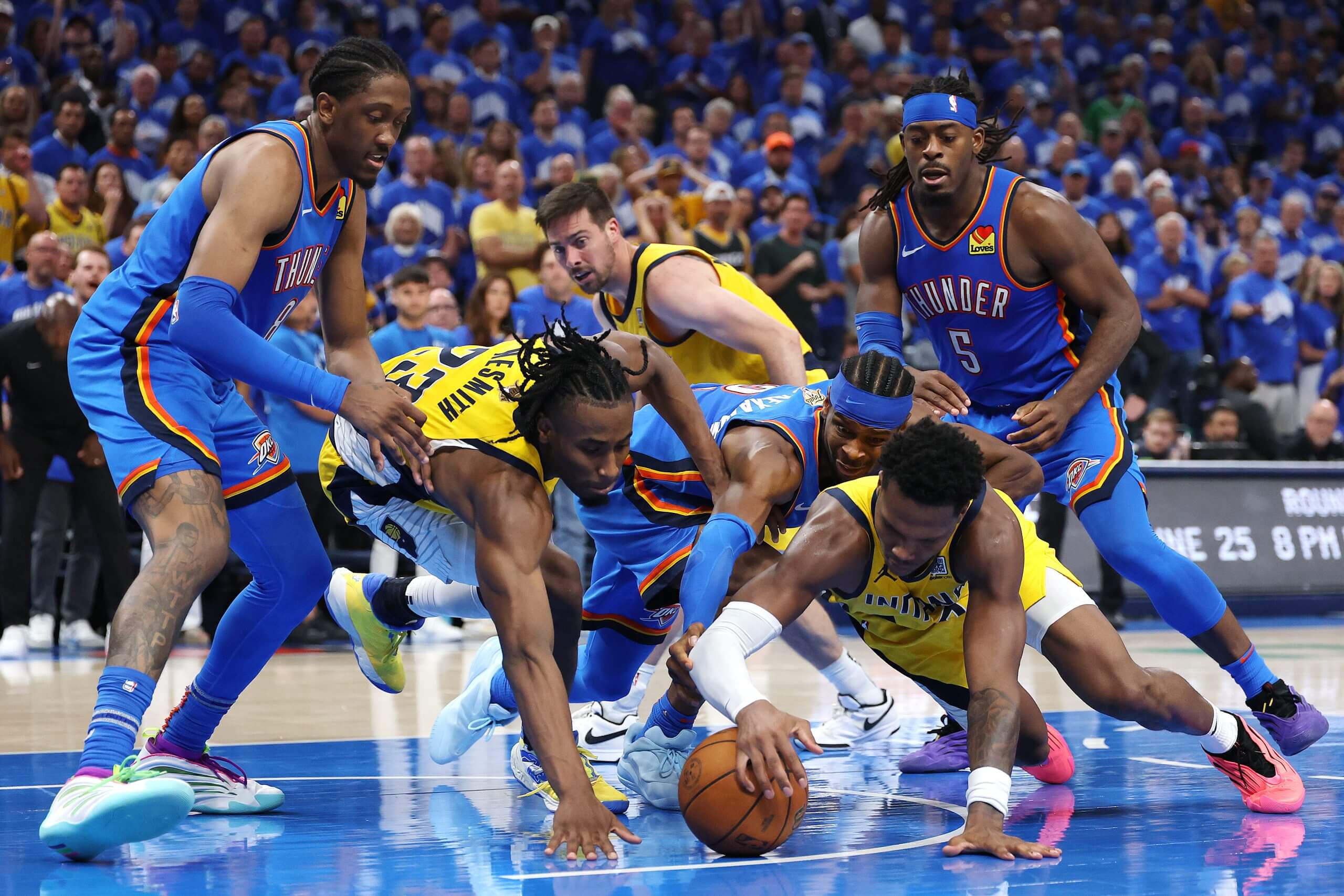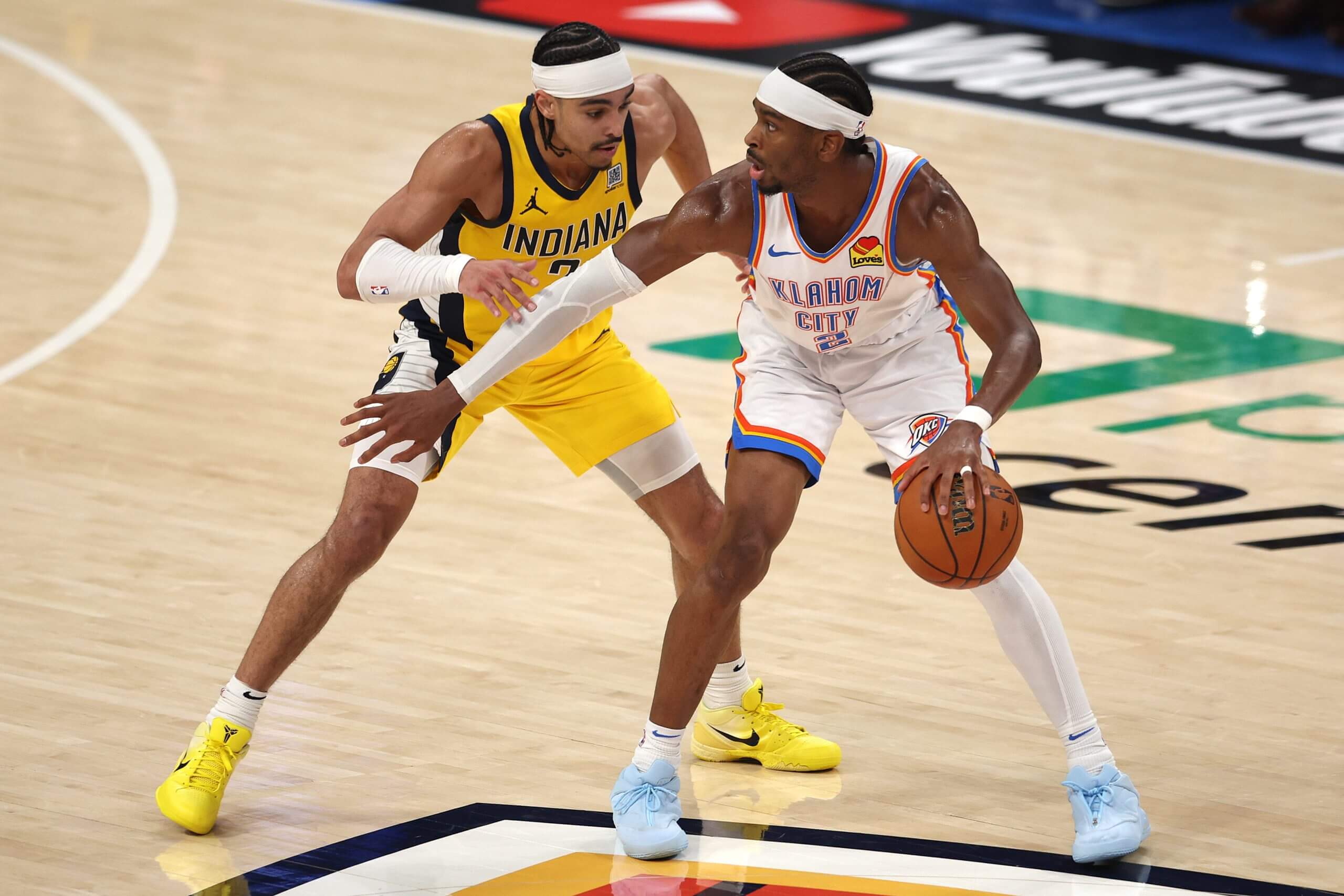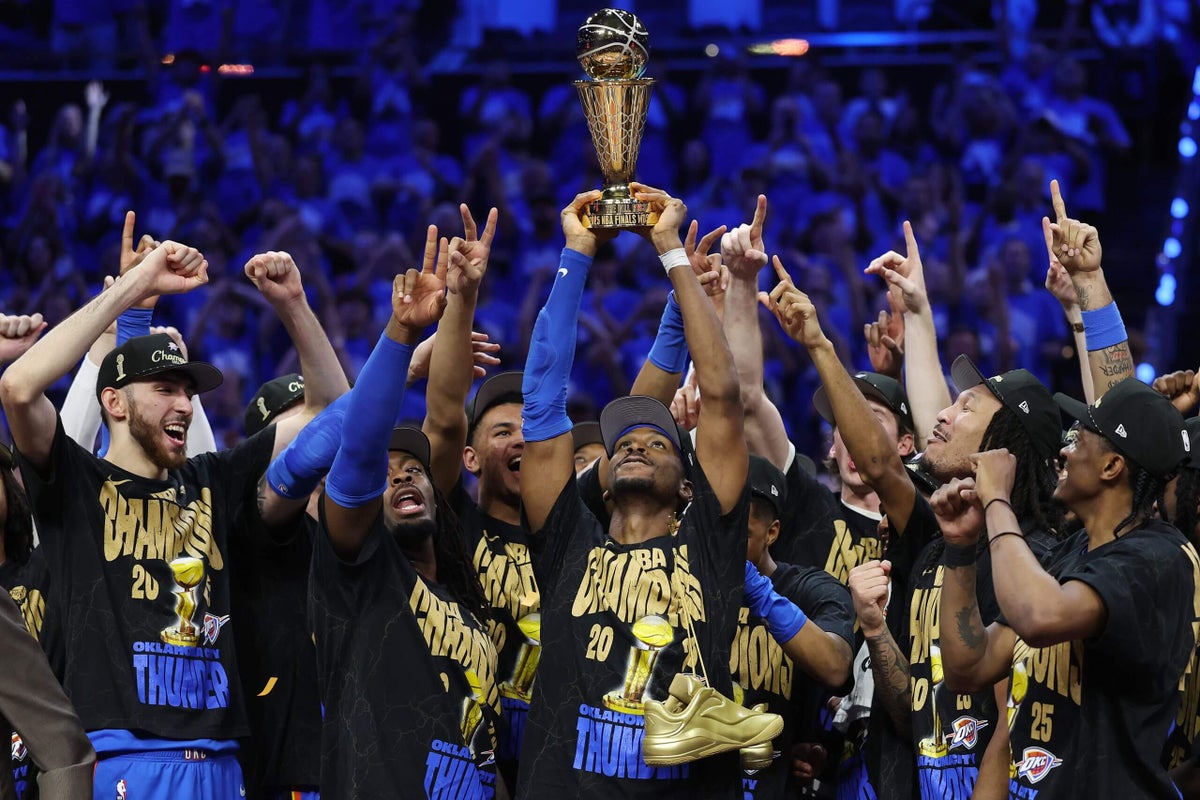By Fred Katz, Law Murray, Eric Nehm, Josh Robbins, Mike Vorkunov and Jared Weiss
The Oklahoma City Thunder are the new kings of the NBA, and their reign figures to be a long one. OKC is a case study in roster construction, asset acquisition, short-term tactics and long-term strategy.
The Thunder’s NBA Finals foe was built in a more traditional yet equally patient and prescient manner, an Indiana Pacers team that wore teams down with seemingly endless actions and breakneck pace.
If the NFL is the ultimate copycat league, then the NBA may not be far behind. The best basketball teams often provide lessons that can serve as a blueprint. Which got us to thinking: What lessons can the newly crowned NBA champion and runner-up offer to the league’s 28 other teams?
We asked our staff writers to identify the trends that this past postseason’s NBA Finals can teach us.
Lesson One: Flood the floor with 3-point shooters
This season’s NBA Finals reminded us yet again about the importance of having many capable 3-point shooters on the floor at once.
In non-garbage time, the Pacers and Thunder usually deployed five-man lineups that featured at least four legitimate 3-point threats who spaced the floor for their teammates. Floor spacing is never more important than in the playoffs, when the pace of a game typically slows down and defenses play with greater intensity for longer stretches.
For his NBA Finals rotation, Oklahoma City coach Mark Daigneault could call on seven players who exceeded the regular-season league average in 3-point shooting of 36 percent: Isaiah Joe, Luguentz Dort, Kenrich Williams, Aaron Wiggins, Chet Holmgren, Shai Gilgeous-Alexander and Jalen Williams. At least four of them were on the floor in each of Daigneault’s three most-used lineups (in terms of total minutes) during the finals.
Indiana’s finals playing rotation featured five guys whose regular-season 3-point percentages exceeded the league average: Aaron Nesmith, Myles Turner, Pascal Siakam, Tyrese Haliburton and Obi Toppin. In addition, Andrew Nembhard, who struggled with his long-range shooting during the regular season, made 48.3 percent of his 3-point tries during the postseason’s first three rounds and then sank 42.3 percent during the finals. It’s no coincidence that four of Rick Carlisle’s five most-used lineups in the finals’ first six games each consisted of at least four of these shooters. (I’m excluding Game 7 from consideration here because Haliburton’s Achilles injury during that game forced Carlisle to alter his rotation.)
Top offenses need to have the capability to play four-out — and preferably, five-out — in the half court. Oklahoma City and Indiana both had that crucial capability. That’s a lesson that these NBA Finals reinforced. — Josh Robbins, Senior NBA Writer
Lesson Two: Master the screen
If we nerds all receive our wish, maybe the least sexy part of basketball will finally receive its time in the spotlight. The two teams that just met in the Finals were also, by no coincidence, the two best-screening squads in the NBA all season. Other offenses can take note.
For years, we’ve heard about how the league was becoming positionless. The Thunder took that concept further than anyone. Oklahoma City boasted the most egalitarian screening offense in history. Everyone, no matter how small or large, had to lay picks. Cason Wallace went from a perimeter guard in college to someone who, at times, was indistinguishable from a big man, so long as you ignored his 6-foot-4 frame.
As to why he all of a sudden became a screener upon entering the NBA, he once told me, “This is how we play, and if you’re not bought into it, you’re not gonna play.”
So Wallace adapted willingly. Now, he sets picks and rolls to the rim, facilitating from there, as do Alex Caruso, Wiggins and the rest of Oklahoma City’s guards and wings.
The Thunder set 28 ball screens per 100 possessions with their guards during the regular season, according to Second Spectrum. No one else in the NBA averaged more than 18.
People talk all the time about it being a copycat league, how teams take from other successful ones. Well, the Pacers and Thunder may be the two most versatile screening teams in the NBA. And they’re the two still playing. https://t.co/gZzJZQdv2L
— Fred Katz (@FredKatz) June 20, 2025
Meanwhile, the Pacers’ success was contingent on its screening style. Indiana isn’t necessarily wrecking defenders with bone-crushing screens. Instead, it often has other objectives.
“Your ultimate goal is to create some kind of contact at some point,” center Myles Turner said. “But we are just trying to free up space.”
The Pacers want to muck up whatever coverage the defense is trying. If an opponent hopes to go over a screen, the Pacers will angle themselves to force him to another part of the court. No team is better than Indiana at “slipping” screens, the action of beginning to roll to the rim or pop to the 3-point arc a tad earlier than expected, most commonly deployed against defenses that are switching on pick-and-rolls.
Siakam is elite at reading a coverage and knowing when he should take off to the hoop early. He and Haliburton combined to be the second-most efficient high-volume pick-and-roll duo in the NBA this season, trailing only the Nuggets’ telepathic Jamal Murray and Nikola Jokić, per Second Spectrum.
Third place on that list? Gilgeous-Alexander and Isaiah Hartenstein, who is especially adept at flat screens. In fourth place, it’s two Pacers again — this time, Haliburton and Turner.
The Pacers and Thunder have mastered screening in ways the other 28 teams have not. — Fred Katz, Senior NBA Writer

Aaron Nesmith and Bennedict Mathurin battle for the ball with Shai Gilgeous-Alexander during Game 7. Both the Pacers and the Thunder were excellent at holding on to the ball and forcing turnovers during the regular season (Photo by Matthew Stockman/Getty Images)Lesson Three: Control the ball
A lesson for the few 2026 contenders, and many more 2026 pretenders and chicken tenders, is about the value of taking care of the basketball.
During the regular season, both the Pacers and the Thunder were ranked in the top three in fewest turnovers per game, lowest turnover percentage and fewest live-ball turnovers per game. The Thunder led the league in fewest fast-break points allowed and had the highest assist-to-turnover ratio; the Pacers ranked second in those categories.
When it comes to personnel, these teams have the All-NBA point guard, a good decision-making All-Star forward complement and a plethora of other options to handle the ball, including another starter and multiple reserves. For the Pacers, that’s Haliburton, Siakam and Nembhard in the starting lineup, with TJ McConnell and Bennedict Mathurin off the bench. Those five players all generated at least 50 touches per game, per Second Spectrum.
The Thunder have Gilgeous-Alexander, Jalen Williams, Holmgren and Hartenstein in the starting lineup, with Wallace and Caruso in reserve. Oklahoma City also had Ajay Mitchell as a backup ballhandler, while redshirting lottery pick Nikola Topić.
And these two teams couldn’t be much more different in play style. Though both teams are relatively drive-heavy, fast-paced teams, only the Golden State Warriors passed the ball more than the Pacers this season. On the flip side, only five teams passed the ball less than the Thunder. Only four teams went to isolation more often than Oklahoma City this season, while only five teams went to isolation fewer times than Indiana, per Synergy.
Run whatever kind of offense you want, but having multiple playmakers should be a priority going forward. — Law Murray, NBA Staff Writer
Lesson Four: Avoid the ‘weak link’
Over the last year, the nerdiest corners of the basketball internet have spent some time thinking about “the weak link theory” and how it has taken on greater importance in the modern NBA. Essentially, the theory posits that the long-held belief that the team with the best player will win a playoff series is no longer accurate. With the high quality of playoff tactics and skill plus the entire league’s ability to find and exploit a mismatch, teams can’t afford to have the “weakest link” on the floor.
Weak links can appear in many forms. While teams used to be able to get away with playing 3-point specialists in the NBA Finals, those players now have to be able to defend and likely need to prove they can do something more offensively than just shoot 3s. Have a big man who can only play drop coverage? Get ready for them to be targeted in pick-and-rolls 30 feet from the hoop. Have a wing player who can’t knock down 3s? They will be ignored and you will be forced to play 4-on-5.
Watching the Thunder and Pacers in this year’s NBA Finals, those weak links were tougher to find. Both rosters are full of average to above-average to very good defenders and the majority of both rosters can dribble, pass and shoot on the offensive end. After getting attacked regularly by the Boston Celtics in the Eastern Conference Finals last season, Haliburton improved his defense and regularly made plays on that end in this year’s finals. Caruso has shot the ball well enough and cut hard enough to stay on the floor, so he can make a massive impact on defense.
As teams approach this offseason and try to build a winning roster, the success of the Pacers and Thunder might encourage them to look for players who can do a little bit of everything rather than taking a bet on a player with one elite skill and real flaws in other regards. Maybe generalists can be more helpful than specialists when it comes to building a contending roster. — Eric Nehm, Senior NBA Writer

The Pacers pressed Shai Gilgeous-Alexander early, forcing high pick-and-rolls. (Photo by William Purnell/Getty Images)Lesson Five: Set a high line of defense
A playoff series often has a tug of war over some line of engagement. In the NFL, each team battles to control the line of scrimmage. In the NBA, teams fight over pick-up points and screen heights, setting the length of the playing area in a possession. Usually, it’s a matter of picking up the ball near the 3-point line or half court, but the Pacers pushed it to a different level for most of the finals.
When the Pacers pressed the Thunder in the backcourt for much of the series, that often set the screening height all the way above half court. That led to the Thunder getting downhill or drawing crossmatches for a second pick-and-roll before the play really ever started. In the last two games of the series, the Pacers steadily retreated their pressure, trying to take away Gilgeous-Alexander’s downhill speed as a tool to get Indiana’s defense into rotation. But the Pacers were constantly gambling on whether they could disrupt the Thunder’s tempo without getting exposed on the second screen attempt a few seconds later.
One of the copycat takeaways we’ll likely see spread next season is more teams experimenting with pressing as a base defense, rather than a curveball. It requires a certain personnel composition. Teams need to have multiple guards and wings who like to run, plus a center who can handle guarding up to the screen level several times a possession. It’s not for the faint of heart, but every team says they want to run more and more in training camp. But now that games are basically turning into track meets, can teams keep pushing the envelope? The Pacers proved this year that the ceiling on the transition era is still far away. — Jared Weiss, NBA Staff Writer
Lesson Six: Construct a deep roster with an eye on the future
The value of these finals, of the success of the Pacers and Thunder, is depth. This might seem axiomatic: having a lot of good players is important. Duh. But it’s never that simple.
A salary cap league, especially one with the newish apron constraints imposed in 2023, demands choices and opportunity costs. The Oklahoma City and Indiana front offices understand this — the Thunder had five players who averaged 13 or more minutes per game this postseason while taking up less than 10 percent of the cap; the Pacers had six.
“Depth, in general, is really important,” Thunder GM Sam Presti said at preseason press conference. “I think depth relative to the parity in the league that we see now is directly linked, because the teams are so deep.”
Depth is probably more valuable than ever. It’s harder to put a roster together with more than two max players, so the strength of a team can no longer tilt heavily in favor of top-heavy talent. That means organizations not only have to hit on picks in the draft — i.e. Wallace and Jalen Williams — but they also need to establish a player development program that can make contributors out of second-round picks, undrafted players and waiver wire finds like Dort, Kendrich Williams, Joe and Wiggins.
Developing these kinds of players will become increasingly important for the Thunder if and when Gilgeous-Alexander, Holmgren and Jalen Williams sign expensive contract extensions. But it’s also important because teams need depth to hang in the NBA now because of the move to a faster pace and to withstand the increased physicality that has come out of looser refereeing.
Depth keyed the Pacers’ finals run, as they used a deep rotation to funnel in players who can run fast, play hard and beat up the opposing team. Indiana has accomplished their own mix of strong drafting and player development, from finding a key player in the second round (Nembhard) to optimizing “second draft” acquisitions (Toppin and Nesmith). — Mike Vorkunov, National NBA Business Reporter
(Photo: Matthew Stockman/Getty Images)
